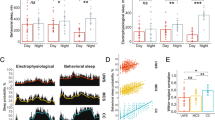Summary
The purpose of the study was to investigate whether the sleep EEG after sleep deprivation has a stronger provocative effect than the drug-induced sleep EEG. For this purpose a sleep EEG, induced by 2 mg/kg body weight of promazine hydrochloride, was recorded. On the following day a sleep EEG of the same patient was recorded after sleep deprivation of 24–26 h. If only patients whose wake EEGs were free from epileptic activity are considered, the rate of provocation was 58%. As epileptic activity could be recorded even in the sleep EEG without sleep deprivation in 45%, the advantage gained by recording a sleep EEG after sleep deprivation (52%) is only relatively small. The occurrence of epileptic activity was shown to be significantly more frequent amongst women and those who developed epilepsy at a younger age. For practical purposes it is recommended that for those patients whose wake EEGs are free from epileptic activity, a sleep EEG—possibly drug-induced—should be recorded. Only in instances where epileptic activity can not then be recorded should a wake EEG after sleep deprivation be carried out, and followed immediately, if necessary, by a sleep EEG.
Zusammenfassung
Der Zweck der Studie war zu untersuchen, ob das Schlaf-EEG nach Schlafentzug einen stärker provozierenden Effekt als das medikamentös induzierte Schlaf-EEG besitzt. Zu diesem Zweck wurde bei 115 Patienten mit komplexen Partialanfällen ein durch 2 mg/kg Körpergewicht Promazinhydrochlorid induziertes Schlaf-EEG und am folgenden Tag vom gleichen Patienten ein Schlaf-EEG nach 24–26stündigem Schlafentzug registriert. Wenn nur Patienten, deren Wach-EEG frei von epileptischer Aktivität war, berücksichtigt werden, betrug die Provokationsrate mit beiden Methoden 58%. Da epileptische Entladungen im Schlaf-EEG ohne Schlafentzug bei bereits 45% aufgezeichnet werden konnten, ist der Gewinn durch das Schlaf-EEG nach Schlafentzug mit 52% nur relativ gering. Bei weiblichem Geschlecht und frühem Erkrankungsbeginn konnte signifikant mehr epileptische Aktivität gefunden werden. Für praktische Zwecke kann empfohlen werden, bei Patienten, deren Wach-EEG Krampfaktivität vermissen läßt, zunächst ein — evtl. medikamentös induziertes — Schlaf-EEG zu registrieren. Nur in Fällen, in denen dabei epileptische Entladungen nicht zu finden sind, sollte ein Wach-EEG nach Schlafentzug aufgezeichnet werden, dem bei Bedarf sofort ein Schlaf-EEG angeschlossen werden kann.
Similar content being viewed by others
References
Bechinger D, Kornhuber HH (1976) The sleep deprivation EEG in childhood. EEG Clin Neurophysiol 65:41 (Abstract)
Bechinger D, Kriebel I (1973) Das Schlafentzug-EEG, ein wichtiges diagnostisches Hilfsmittel bei zerebralen Anfällen. Z Neurol 205:194–206
Bente D, Itil TM (1954) Zur Wirkung des Phenothiazinkörpers Megaphen auf das menschliche Hirnstrombild. Arzneimittelforsch 4:418–423
Christian W (1961) Schlaf-Wach-Periodik bei Schlaf- und Aufwachepilepsien. Nervenarzt 32:266–275
Degen R (1977) Die diagnostische Bedeutung des Schlafs nach Schlafentzug unter antiepileptischer Therapie. Nervenarzt 48:314–320
Degen R (1980) A study of the diagnostic value of resting and sleeping EEGs after sleep deprivation in epileptic patients on anticonvulsive therapy. EEG Clin Neurophysiol 49:577–584
Delange M, Castan P, Cailhac J, Passizabt P (1962) Etude du sommeil de nuit au cours d'épilepsies centrencephaliques et temporales. Rev neurol 106:106–113
Fuster B (1953) EEG activation and natural or induced sleep. EEG Clin Neurophysiol [Suppl] 4:108–120
Gänshirt H, Vetter K (1961) Schlafelektroencephalogramm und Schlaf-Wach-Periodik bei Epilepsien. Nervenarzt 32:275–279
Geller MR, Gourdji N, Christoff N, Fox E (1969) The effects of sleep deprivation on the EEGs of epileptic children. Develop Med Child Neurol 11:771–776
Gibbs EL, Gibbs FA (1947) Diagnostic and localizing value of electroencephalographic studies in sleep. Res Publ Assoc Res Nerv Ment Dis 26:366–376
Glaser GH (1967) Limbic epilepsy in childhood. J Nerv Ment Dis 144:391–397
Glaser GH, Golub LM (1955) The electroencephalogram of psychomotor seizures in childhood. EEG Clin Neurophysiol 7:329–340
Gloor P, Tsai C, Haddad F (1958) An assessment of the value of sleep-electroencephalography for the diagnostic of temporal lobe epilepsy. EEG Clin Neurophysiol 10:633–648
Itil TM (1961) Elektroencephalographischer Befund zur Klassifikation neuro-und thymoleptischer Medikamente. Med Exp Basel 5:347–363
Itil TM (1970) Convulsive and anticonvulsive properties of neuro-psychopharmaca. In: Niedermeyer E (ed) Epilepsy. Recent views on theory, diagnosis and therapy of epilepsy. Karger, Basel-New York, pp 270–305
Janz D (1962) The grand mal epilepsies and the sleeping-waking cycle. Epilepsia 3:69–109
Jovanović VJ (1967) Das Schlafverhalten der Epileptiker. II. Elemente des EEG, Vegetativum und Motorik. Dtsch Z Nervenheilk 191:257–290
Kikuchi S (1969) An electroencephalographic study of nocturnal sleep in temporal lobe epilepsy. Folia Psychiat Neurol Jpn 23:59–81
Klass DW (1976) Electroencephalographic manifestations of complex partial seizures. In: Penry IK, Daly DD (eds) Advances in neurology, vol 11: Complex partial seizures. Raven Press, New York
Kugler I (1960) Chemotherapie der Depression und EEG. Wien Klin Wochenschr 72:465–468
Loomis AL, Harvey N, Hobart GA (1937) Cerebral states during sleep as studied by human brain potentials. J Exp Psychol 21:127–144
Matthes A (1961) Die psychomotorische Epilepsie im Kindesalter. Z Kinderheilk 85:455–471; 472–492; 668–685
Mattson RH, Pratt KL, Calverley IR (1965) Electroencephalograms of epileptics following sleep deprivation. Arch Neurol 13:310–315
Merlis IK, Grossmann C, Henriksen GF (1951) Comparative effectiveness of sleep and metrazol-activated electroencephalography. EEG Clin Neurophysiol 3:71–78
Niedermeyer E, Rocca W (1972) The diagnostic significance of sleep electroencephalograms in temporal lobe epilepsy. Eur Neurol 7:119–129
Pratt KK, Mattson RH, Weikers NJ, Williams R (1968) EEG activation of epileptics following sleep deprivation: a prospective study of 114 cases. EEG Clin Neurophysiol 24:11–15
Ritter B, Becker A, Duensing F (1977) Zum diagnostischen Wert des EEGs nach Schlafentzug. Nervenarzt 48:365–368
Rumpl E, Lorenzi E, Bauer G, Hengl W (1977) Zum diagnostischen Wert des EEG nach Schlafentzug. Z EEG-EMG 8:205–209
Shea JG, Ehrmantraut WR, Richtin HE, Sullivan PD Jr, Fazekas JF (1956) Use of promazine in the management of medical emergencies. Milit Med 119:221–227
White P, Dyken M, Grant P, Jackson L (1962) Electroencephalographic abnormalities during sleep as related to the temporal distribution of seizures. Epilepsia 3:167–174
Author information
Authors and Affiliations
Additional information
Supported by the Deutsche Forschungsgemeinschaft
Rights and permissions
About this article
Cite this article
Degen, R., Degen, H.E. A comparative study of the diagnostic value of drug-induced sleep EEGs and sleep EEGs following sleep deprivation in patients with complex partial seizures. J Neurol 225, 85–93 (1981). https://doi.org/10.1007/BF00313322
Received:
Issue Date:
DOI: https://doi.org/10.1007/BF00313322



